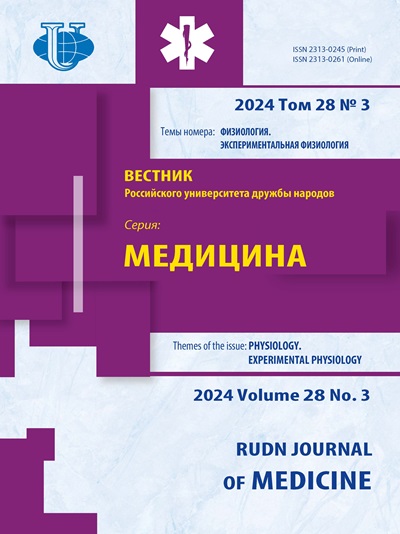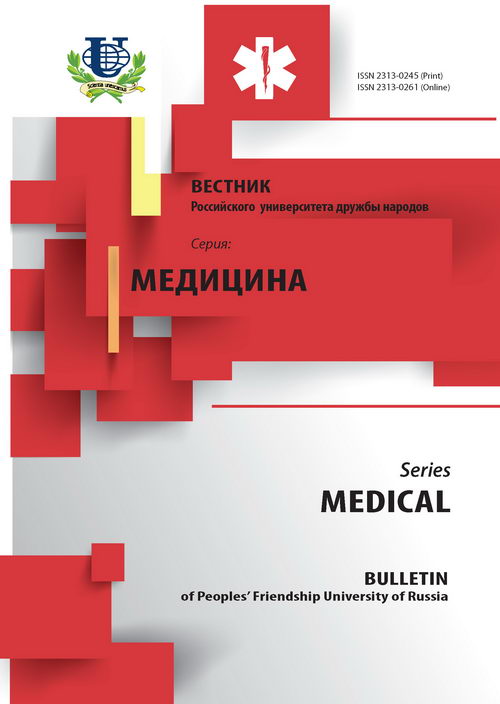Роль инфекционно-генетических факторов в реализации преждевременных родов
- Авторы: Мусалаева И.О.1, Махтибекова З.А.1, Кострикова А.В.1, Эфендиева Ж.М.1
-
Учреждения:
- Российский университет дружбы народов
- Выпуск: № 2 (2016)
- Страницы: 171-175
- Раздел: Статьи
- URL: https://journals.rudn.ru/medicine/article/view/3346
Цитировать
Полный текст
Аннотация
В статье представлен литературный обзор источников последних лет по преждевременным родам (ПР). Описаны основные методы дородовой диагностики ПР, методы выявления хориоамнионита на ранних сроках, а также связь ПР с генетическими маркерами, которые также могут использоваться для скрининга высокого риска ПР у женщин на ранних сроках беременности для выделения группы высокого риска и своевременного проведения им профилактических мероприятий.
Ключевые слова
Об авторах
Индира Омаровна Мусалаева
Российский университет дружбы народов
Email: i700@mail.ru
Зухра Арсланалиевна Махтибекова
Российский университет дружбы народов
Email: zuzuzu-xa@mail.ru
Антонина Владимировна Кострикова
Российский университет дружбы народов
Email: antoninakostrikova@mail.ru
Жанна Мамедовна Эфендиева
Российский университет дружбы народов
Email: zhannaefendieva@gmail.com
Список литературы
- Allen-Daniels M.J., Serrano M.G., Pflugner L.P. еt al. Identification of a gene in Mycoplasma hominis associated with preterm birth and microbial burden in intraamniotic infection. Am. J. Obstet. Gynecol. 2015. Vol. 212. Iss. 6. P. 779.
- Arakelyan V.F. Features of vaginal biocenosis with threatening preterm labor: dissertation of the PhD. 2015. Р. 21.
- Bartkeviciene D., Pilypiene I., Drasutiene G. Leukocytosis as a prognostic marker in the development of fetal inflammatory response syndrome. Libyan J. Med. 2013. Vol. 8.
- Bream E.N., Leppellere C.R., Cooper M.E. et al. Candidate gene linkage approach to identify DNA variants that predispose to preterm birth. Pediatr. Res. 2013. Vol. 73. Iss. 2. P. 135-41.
- Chalermchokchareonkit A., Phoethong S., Ruangvutilert P. et al. Prevalence of positive culture of genitourinary tract microorganisms in pregnant women with presumptive preterm labor. J. Med. Assoc. Thai. 2013. Vol. 96. Iss. 9. P. 1111-1118.
- Choi S.J., Park S.D., Jang I.H. et al. The prevalence of vaginal microorganisms in pregnant women with preterm labor and preterm birth. Ann. Lab. Med. 2012. Vol. 32. Iss. 3. P. 194-200.
- Christiaens I., Ang Q.W., Gordon L.N. et al. Two novel genetic variants in the mineralocorticoid receptor gene associated with spontaneous preterm birth. BMC Med. Genet. 2015. Vol. 16. P. 59.
- Critchfield A.S., Yao G., Jaishankar A., Friedlander R.S. et al. Cervical mucus properties stratify risk for preterm birth. PLoS One. 2013 Vol. 8. Iss. 8.
- Baldwin Elizabeth A., Walther-Antonio Marina et al. Persistent microbial dysbiosis in preterm premature rupture of membranes from onset until delivery. Peer. J. 2015. Vol. 3.
- Hernandez-Andrade E., Romero R., Korzeniewski S.J. et al. Cervical strain determined by ultrasound elastography and its association with spontaneous preterm delivery. J. Perinat. Med. 2014. Vol. 42. Iss. 2. P. 159-69.
- Krupitzki H.B., Gadow E.C., Gili J.A. et al. Environmental risk factors and perinatal outcomes in preterm newborns, according to family recurrence of prematurity. Am. J. Perinatol. 2013. Vol. 30. Iss. 6. P. 451-461.
- Langmia I.M., Apalasamy Y.D., Omar S.Z. et al. Progesterone Receptor (PGR) gene polymorphism is associated with susceptibility to preterm birth. BMC Med. Genet. 2015. Vol. 16. P. 63.
- Materials of the scientific program “IV of the сonference” Infections and infection control in obstetrics and gynecology (Moscow, 19 November 2015 - 21 November 2015).
- Matthew W. Kemp. Preterm birth, intrauterine infection, and fetal inflammation. PubMed. 2014. Vol. 5. P. 574.
- Radsinskiy V.Е. Obstetrics. 2015. P. 728.
- Rocha F.G., Slavin T.P., Li D. et al. Genetic associations of relaxin: preterm birth and premature rupture of fetal membranes. Am. J. Obstet. Gynecol. 2013. Vol. 209. Iss. 3. P. 258.e1-8.
- Romero R., Dey S.K., Fisher S.J. Preterm labor: one syndrome, many causes. Science. 2014. Vol. 15. Iss. 345(6198). P. 760-765.
- Wang Y., Yang X., Zheng Y. et al. The SEPS1 G-105A polymorphism is associated with risk of spontaneous preterm birth in a Chinese population. PLoS One. 2013. Vol. 11. Iss. 8(6).
- York T.P., Eaves L.J., Neale M.C. et al. The contribution of genetic and environmental factors to the duration of pregnancy. Am. J. Obstet. Gynecol. 2014. Vol. 210. Iss. 5. P. 398-405.
















